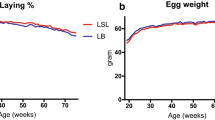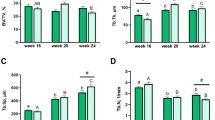Abstract
The medullary bone in the femora of laying hens and of oestrogen-treated cocks has been examined by histological, histochemical, alpharadiographic and microroentgenographic techniques while undergoing both natural resorption and resorption induced by injection of parathyroid extract. In the hens, natural resorption was brought about by egg-shell formation and in the cocks by withdrawal of oestrogen. Natural resorption was accompained by increasing basophilia, azurophilia and metachromasia and by decreasing alpharadiographic and microradiographic density of the trabeculae of the medullary bone. These changes were observed initially in the central region (towards the marrow cavity) and subsequently in the peripheral regions also, where the number of osteocytes per unit area of bone was less. Parathyroid extract enhanced all these effects.
It appears that resorption of medullary bone was brought about by osteocytic osteolysis and by osteoclasis, but it was not possible to determine whether both processes occurred concurrently or whether the osteoclasts attacked the trabeculae only after they had been partially degraded by osteolysis.
These results are consistent with the hypothesis that the natural resorption of medullary bone during egg-shell formation in hens and following the withdrawal of oestrogen in cocks is induced by parathyroid hormone.
Résumé
L'os médullaire des poules au moment de la ponte ainsi que l'os néoformé de coqs soumis à des substances oestrogéniques, ont été examinés par les méthodes de l'histologie, de l'histochimie, de la microradiographie et de l'alpharadiographie afin de comparer la résorption naturelle à celle produite par la parathormone.
Chez les pondeuses, la résorption a été provoquée par la formation de la coquille; chez les coqs, elle s'est produite à la suite de la diminution du taux des oestrogènes.
La résorption naturelle de l'os médullaire a été marquée par un accroissement de la basophilie, de l'azurophilie et de la metachromasie, par la diminution graduelle de la densité organique et minérale.
Ces modifications ont été observées d'abord dans la portion distale de l'os médullaire; elles se sont progressivement propagées à la région sous corticale.
L'extrait parathyroidien semble avoir favorisé tous ces phénomènes, en stimulant l'ostéolyse ostéocytaire et l'ostéoclasie. Il ne nous a pas été possible cependant de nous rendre compte si les ostéoclastes ne se sont attaqués qu'aux portions des travées déja modifiées par l'ostéolyse.
Ces résultats concordent avec l'idée que la résorption normale de l'os médullaire de la poule au temps où la coquille de l'oeuf se dépose, est déclanchée par la parathormone. Il en est de même chez le coq à la suite du retrait des oestrogènes.
Zusammenfassung
Die Substantia spongiosa der Femora von Legehennen und von Hähnen die mit Östrogen behandelt waren, wurde während spontaner und künstlicher, mit Extrakten von Epithelkörperchen induzierter, Resorption einer histologischen, histochemischen, alpharadiographischen und mikroröntgenographische Untersuchung unterworfen. Die natürliche Resorption wurde bei den Hennen durch die Eischalenproduktion und bei den Hähnen durch Östrogenentzug hervorgerufen. Die natürliche Resorption war durch erhöhte Basophilie, Azurphilie und Metachromasie, sowohl als auch durch verminderter alpharadiographischer und mikroröntgenographischer Dichte der Trabeculae der Substantia spongiosa charakterisiert. Diese Veränderungen wurden zuerst in den zentralen, dem Cavum medullare nächstgelegenen, Teilen der Spongiosa wahrgenommen. Später waren auch die peripheren Teile, mit geringerer Osteocytenkonzentration, betroffen. Diese Veränderungen konnten durch Gaben von Epithelkörperchenextrakten verstärkt werden.
Die Resorption der Spongiosa wird durch osteocytische Osteolyse und Osteoklasie bewirkt. Es konnte aber nicht entschieden werden ob diese beiden Prozesse gleichzeitig stattfinden, oder ob die Osteoklasten die Trabeculae erst angreifen, nachdem sie bereits teilweise durch Osteolyse abgebaut worden sind.
Diese Resultate stimmen mit der Hypothese überein, daß die natürliche Resorption von Spongiosa während der Eischalenproduktion bei Hennen und nach Entzug von Östrogen bei Hähnen, durch Epithelkörperchenhormonen bedingt ist.
Similar content being viewed by others
References
Belanger, L. F., Belanger, C.: Alpharadiography: a simple method for determination of mass concentration in cells and tissues. J. biophys. biochem. Cytol.6, 197–202 (1959).
— Copp, D. H., Morton, M. A.: Demineralization with EDTA by constant replacement. Anat. Rec.153, 41–47 (1965).
— Hartnett, A.: Persistent toluidine blue metachromasia. J. Histochem. Cytochem.8, 75 (1960).
— Robichon, J., Migicovsky, B. B., Copp, D. H., Vincent, J.: Resorption without osteoclasts (Osteolysis). In: Mechanisms of hard tissue destruction (Sognnaes, R. F., ed.), p. 531–556. Washington D. C.: American Association for the Advancement of Science 1963.
— Semba, T., Tolnai, S., Copp, D. H., Krook, L., Gries, C.: The two faces of resorption. 3rd European Symposium on Calcified Tissues. (Fleisch, H., Blackwood, H. J. J., Owen, M., eds.), p. 1–9. Berlin-Heidelberg-New York: Springer 1966.
— Van Erkel, G. A., Jakerow, A.: Behaviour of the dermal mast cells in magnesium deficient rats. Science126, 29–30 (1957).
Bloom, M. A., Domm, L. V., Nalbandov, A. V., Bloom, W.: Medullary bone of laying chickens. Amer. J. Anat.102, 411–453 (1958).
Bloom, W., Bloom, M. A., McLean, F. C.: Calcification and ossification. Medullary bone changes in the reproductive cycle of female pigeons. Anat. Rec.87, 443–475 (1941).
Gillings, B., Buonacore, M.: An apparatus for the preparation of thin serial sections of undecalcified tissues. J. dent. Res.38, 1156–1165 (1959).
Kyes, P., Potter, T. S.: Physiological marrow ossification in female pigeons. Anat. Rec.60, 377–379 (1934).
Riddle, O., Rauch, V. M., Smith, G. C.: Action of estrogen on plasma calcium and endosteal bone formation in parathyroidectomised pigeons. Endocrinology,36, 41–47 (1945).
Simkiss, K.: Calcium metabolism and avian reproduction. Biol. Rev.36, 321–367 (1961).36, 321–367 (1961).
— Calcium in reproductive physiology, p. 155–197. London: Chapman and Hall 1967.
Stringer, D. A.: The chemistry and physiology of bone. Ph. D. Thesis, University of Reading (1962).
Taylor, T. G.: Calcium-endocrine relationships in the laying hen. Proc. Nutr. Soc.24, 49–54 (1965).
Taylor, T. G.: The role of the skeleton in eggshell formation. Ann. Biol. anim. (in press, 1969).
— Hertelendy, F.: Changes in the blood calcium associated with eggshell calcification in the domestic fowl. 2. Changes in the diffusible calcium. Poultry Sci.40, 115–123 (1961).
— Stringer, D. A.: Eggshell formation and skeletal metabolism. In: Avian physiology, II. ed. (Sturkie, P. D., ed.), p. 155–197. Ithaca, New York: Cornell University Press 1965.
Urist, M. R.: The effects of calcium deprivation upon the blood, adrenal cortex, ovary and skeleton in the domestic fowl. Recent Progr. Hormone Res.15, 455–477 (1959).
— Deutsch, N. M., Pomerantz, G., McLean, F. C.: Interrelations between actions of parathyroid hormone and estrogens on bone and blood in avian species. Amer. J. Physiol.199, 851–855 (1960).
Author information
Authors and Affiliations
Rights and permissions
About this article
Cite this article
Taylor, T.G., Belanger, L.F. The mechanism of bone resorption in laying hens. Calc. Tis Res. 4, 162–173 (1969). https://doi.org/10.1007/BF02279117
Received:
Issue Date:
DOI: https://doi.org/10.1007/BF02279117




